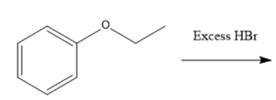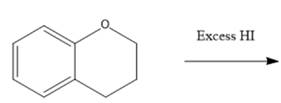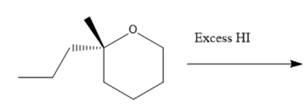
Concept explainers
(a)
Interpretation: The major product formed in the given reaction needs to be identified.

Concept Introduction: To solve the given problem, reactions shown by ethers need to be studied in detail. Generally, ether does not react under mildly acidic or basic conditions. Because of this, they are used as a solvent in many reactions. Ethers can show an acidic cleavage reaction when heated in the presence of excess HX. This process involves two substitution reactions.
(b)
Interpretation: The major product formed in the given reaction needs to be identified.

Concept Introduction: To solve the given problem, reactions shown by ethers need to be studied in detail. Generally, ether does not react under mildly acidic or basic conditions. Because of this, they are used as a solvent in many reactions. Ethers can show an acidic cleavage reaction when heated in the presence of excess HX. This process involves two substitution reactions.
(c)
Interpretation: The major product formed in the given reaction needs to be identified.

Concept Introduction: To solve the given problem, reactions shown by ethers need to be studied in detail. Generally, ether does not react under mildly acidic or basic conditions. Because of this, they are used as a solvent in many reactions. Ethers can show an acidic cleavage reaction when heated in the presence of excess HX. This process involves two substitution reactions.
(d)
Interpretation: The major product formed in the given reaction needs to be identified.

Concept Introduction: To solve the given problem, reactions shown by ethers need to be studied in detail. Generally, ether does not react under mildly acidic or basic conditions. Because of this, they are used as a solvent in many reactions. Ethers can show an acidic cleavage reaction when heated in the presence of excess HX. This process involves two substitution reactions.
(e)
Interpretation: The major product formed in the given reaction needs to be identified.

Concept Introduction: To solve the given problem, reactions shown by ethers need to be studied in detail. Generally, ether does not react under mildly acidic or basic conditions. Because of this, they are used as a solvent in many reactions. Ethers can show an acidic cleavage reaction when heated in the presence of excess HX. This process involves two substitution reactions.
(f)
Interpretation: The major product formed in the given reaction needs to be identified.

Concept Introduction: To solve the given problem, reactions shown by ethers need to be studied in detail. Generally, ether does not react under mildly acidic or basic conditions. Because of this, they are used as a solvent in many reactions. Ethers can show an acidic cleavage reaction when heated in the presence of excess HX. This process involves two substitution reactions.
Want to see the full answer?
Check out a sample textbook solution
Chapter 13 Solutions
EBK ORGANIC CHEMISTRY-STUD.SOLNS.MAN+SG
- Given a complex reaction with rate equation v = k1[A] + k2[A]2, what is the overall reaction order?arrow_forwardPlease draw the structure in the box that is consistent with all the spectral data and alphabetically label all of the equivalent protons in the structure (Ha, Hb, Hc....) in order to assign all the proton NMR peaks. The integrations are computer generated and approximate the number of equivalent protons. Molecular formula: C13H1802 14 13 12 11 10 11 (ppm) Structure with assigned H peaks 2.08 3.13arrow_forwardCHEMICAL KINETICS. One of the approximation methods for solving the rate equation is the steady-state approximation method. Explain what it consists of.arrow_forward
- CHEMICAL KINETICS. One of the approximation methods for solving the rate equation is the limiting or determining step approximation method. Explain what it consists of.arrow_forwardCHEMICAL KINETICS. Indicate the approximation methods for solving the rate equation.arrow_forwardTRANSMITTANCE เบบ Please identify the one structure below that is consistent with the 'H NMR and IR spectra shown and draw its complete structure in the box below with the protons alphabetically labeled as shown in the NMR spectrum and label the IR bands, including sp³C-H and sp2C-H stretch, indicated by the arrows. D 4000 OH LOH H₂C CH3 OH H₂C OCH3 CH3 OH 3000 2000 1500 HAVENUMBERI-11 1000 LOCH3 Draw your structure below and label its equivalent protons according to the peak labeling that is used in the NMR spectrum in order to assign the peaks. Integrals indicate number of equivalent protons. Splitting patterns are: s=singlet, d=doublet, m-multiplet 8 3Hb s m 1Hd s 3Hf m 2Hcd 2Had 1He 鄙视 m 7 7 6 5 4 3 22 500 T 1 0arrow_forward
- Relative Transmittance 0.995 0.99 0.985 0.98 Please draw the structure that is consistent with all the spectral data below in the box and alphabetically label the equivalent protons in the structure (Ha, Hb, Hc ....) in order to assign all the proton NMR peaks. Label the absorption bands in the IR spectrum indicated by the arrows. INFRARED SPECTRUM 1 0.975 3000 2000 Wavenumber (cm-1) 1000 Structure with assigned H peaks 1 3 180 160 140 120 100 f1 (ppm) 80 60 40 20 0 C-13 NMR note that there are 4 peaks between 120-140ppm Integral values equal the number of equivalent protons 10.0 9.0 8.0 7.0 6.0 5.0 4.0 3.0 2.0 1.0 0.0 fl (ppm)arrow_forwardCalculate the pH of 0.0025 M phenol.arrow_forwardIn the following reaction, the OH- acts as which of these? NO2-(aq) + H2O(l) ⇌ OH-(aq) + HNO2(aq)arrow_forward
- Using spectra attached, can the unknown be predicted? Draw the predicition. Please explain and provide steps. Molecular focrmula:C16H13ClOarrow_forwardCalculate the percent ionization for 0.0025 M phenol. Use the assumption to find [H3O+] first. K = 1.0 x 10-10arrow_forwardThe Ka for sodium dihydrogen phosphate is 6.32 x 10-8. Find the pH of a buffer made from 0.15 M H2PO4- and 0.25 M HPO42- .arrow_forward

 Organic ChemistryChemistryISBN:9781305580350Author:William H. Brown, Brent L. Iverson, Eric Anslyn, Christopher S. FootePublisher:Cengage Learning
Organic ChemistryChemistryISBN:9781305580350Author:William H. Brown, Brent L. Iverson, Eric Anslyn, Christopher S. FootePublisher:Cengage Learning

